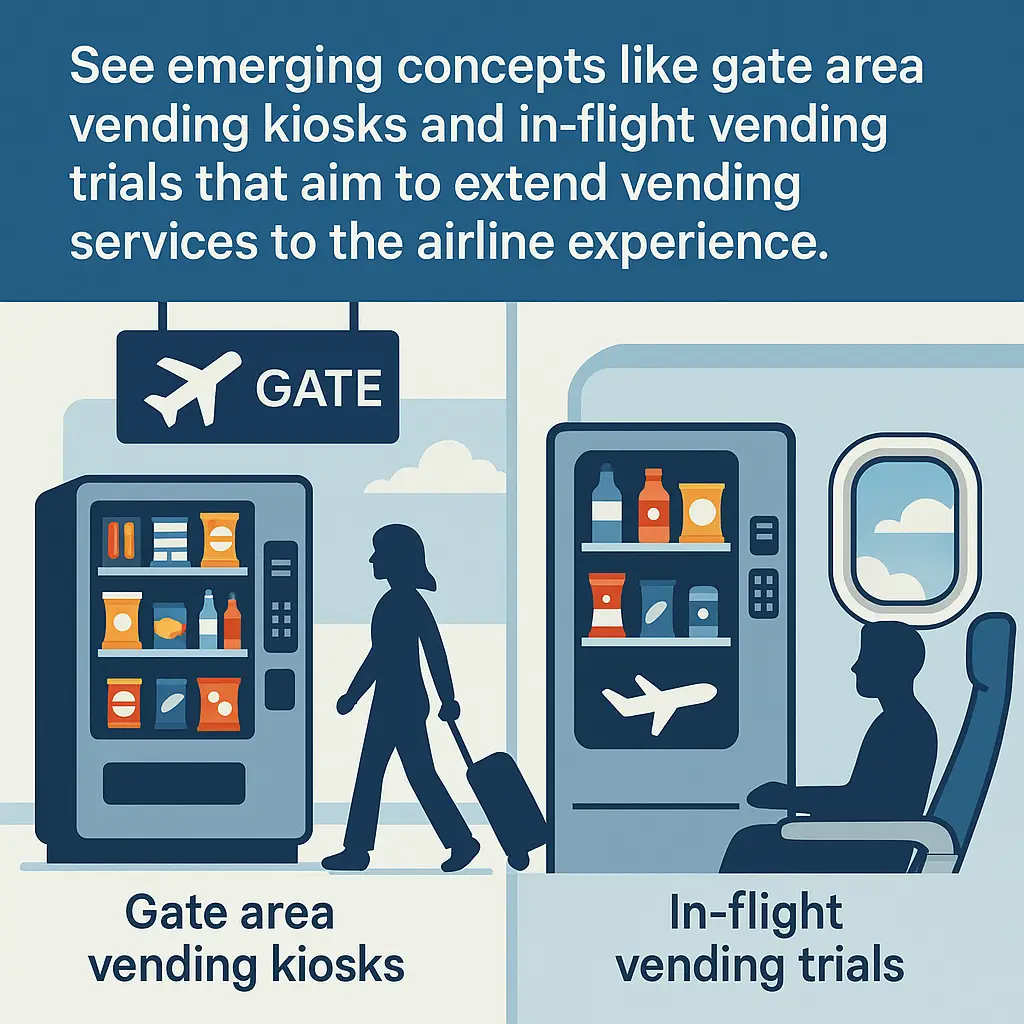In-Flight and Gate Area Vending Innovations
See emerging concepts like gate area vending kiosks and in-flight vending trials that aim to extend vending services to the airline experience.
Back to Vending for Airports ResourcesSee emerging concepts like gate area vending kiosks and in-flight vending trials that aim to extend vending services to the airline experience.
Back to Vending for Airports ResourcesThey provide convenient, self-service access to snacks and essentials at gates or mid-flight, reducing reliance on limited concessions or cart service.
![]() Gate kiosks offer convenient access before boarding flights
Gate kiosks offer convenient access before boarding flights
![]() In-flight vending expands service beyond traditional concessions
In-flight vending expands service beyond traditional concessions
![]() Smart payments improve speed and reliability in secure areas
Smart payments improve speed and reliability in secure areas

Airports are constantly looking for new ways to enhance the traveler experience while maintaining efficient operations. One of the most promising innovations is the introduction of gate area vending kiosks and early trials of in-flight vending services. These concepts aim to give passengers more convenient access to refreshments and travel essentials, especially in areas where traditional concessions may be limited or crowded.
Secure gate areas often leave travelers with few food and beverage options, particularly during off-peak hours. Gate kiosks fill this gap by offering self-service access to snacks, drinks, and travel essentials right where passengers wait to board. This minimizes the need for travelers to leave their gate in search of refreshments, improving both convenience and on-time boarding. These kiosks are designed to fit seamlessly into existing terminal layouts and can handle high traffic without requiring additional staffing.
Airports exploring strategic placement can learn from location planning best practices in high-traffic zones to maximize sales and traveler satisfaction.
Some airlines are experimenting with in-flight vending units to supplement traditional beverage cart service. This approach allows passengers to purchase items on their own schedule, reducing congestion in the aisles and freeing up crew time. Itâs especially useful on longer flights or those with limited catering options. For airports, this concept can create operational efficiencies by shifting some sales activity onboard, potentially easing demand at gate concessions.
For operators considering broader vending strategies, reviewing logistical considerations can help anticipate staffing, security, and maintenance needs.
Operating in secure airport zones brings unique challenges for payments. Gate kiosks and in-flight vending rely on contactless and mobile payment systems that integrate with secure networks to ensure reliability and compliance. Smart vending technologies also allow for real-time inventory monitoring, helping teams keep machines stocked and minimize downtime. This is particularly important in airports, where restocking opportunities are tightly scheduled and require coordination with security teams.
To better understand how technology supports efficient vending operations, explore smart vending innovations that are shaping the future of service.
If you're exploring vending options for your business, Vending Exchange can help simplify the process. Delivery, Installation and Equipment is provided at no cost to you - vendors provide the machines, keep them stocked, and handle all servicing. Whether you need a provider or full-service management, just fill out the form on this page to get started.
They are self-service kiosks placed near boarding gates, offering passengers easy access to snacks, drinks, and travel essentials while they wait.
Yes. Some airlines are trialing in-flight vending systems to supplement standard beverage service, giving passengers more flexibility.
They typically rely on mobile and contactless payment systems integrated with secure airport networks to ensure compliance and reliability.
Popular items include bottled beverages, packaged snacks, travel accessories, and personal care products suitable for carry-on use.
Regular restocking, accurate demand forecasting, and real-time monitoring help ensure freshness and prevent stockouts.
It provides passengers with flexible purchasing options, reduces service congestion, and helps airlines improve onboard efficiency.
No. They are designed for unattended operation, with remote monitoring and scheduled restocking to keep them running efficiently.
Restocking typically happens during approved time windows coordinated with security teams, often during low-traffic hours.
Yes. Because they are self-service, kiosks can remain available 24/7, even when traditional concessions are closed.
Units must meet airline safety standards, support secure payments, and comply with aviation security regulations.